

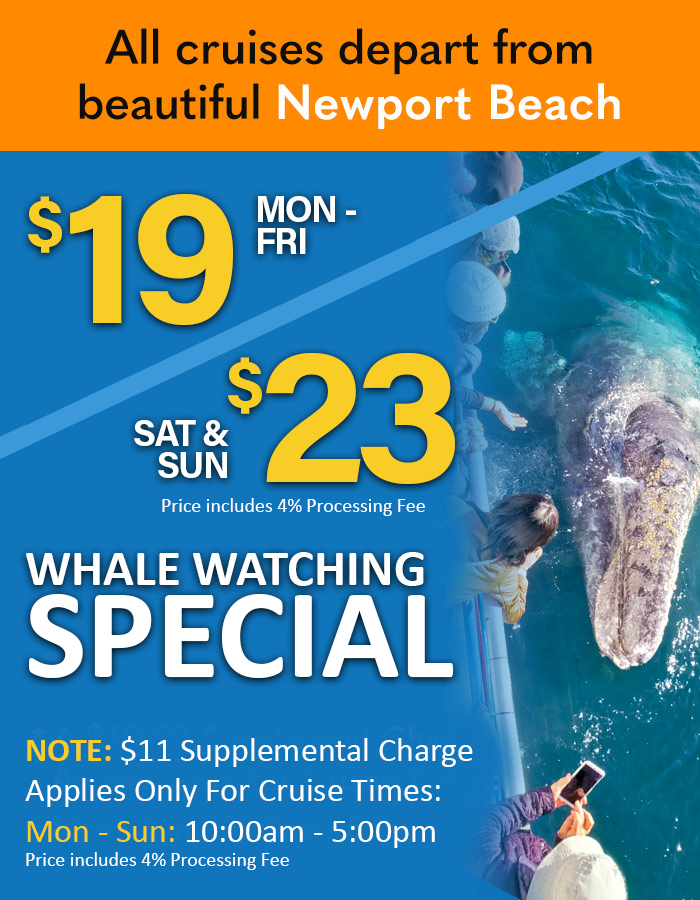
CLICK HERE TO CLAIM OFFER
Providing whale watching off Dana Point and Laguna Beach for over 30 years, Newport Landing offers multiple cruises daily year round to view whales and dolphin. Dana Point whale watching visitors find that Newport Landing is a closer option for those traveling from Los Angeles and most of Orange County. 5 star whale watching experiences and a half price whale watching cruise rate of only $18 means you only pay 1/3 the price of other whale watching providers in Dana Point and yet see as many if not more whales and dolphin.
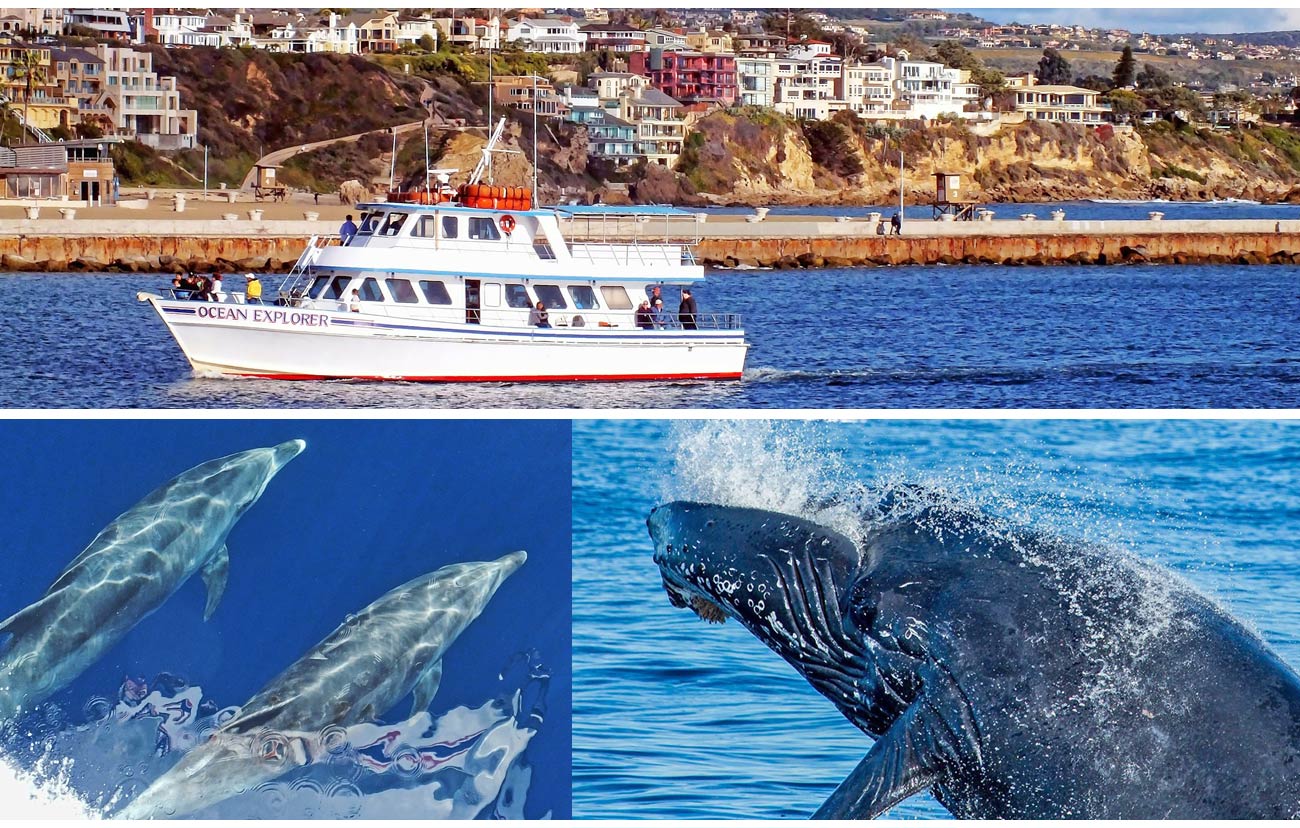
Whale Watching for Dana Point Visitors

Whale Watching Dana Point visitors during the Winter and Spring will get a chance to see Grey Whales migrating to and from their breeding grounds in Baja California when attending a Whale Watching cruise in Newport Landing. Whale Watching Dana Point visitors will also have a chance to see the largest animal to ever existed, the Blue Whale, during the Summer and Fall months. These gigantic beasts consume over four to six tons of krill each day - their hearts are the size of a small car!
Throughout the year Whale Watching Dana Point visitors will also encounter Common Dolphins, Bottlenose Dolphins, Orca Whales, Humpback Whales, Finback Whales, Minke Whales, Sperm Whales, Sea Lions and their pups, as well as a variety of other types of marine wildlife. Coming from nearby Dana Point, Whale Watching Dana Point visitors will be sure to enjoy a nice relaxing cruise out at sea viewing wildlife in their natural habitats.
Coming from Dana Point, Whale Watching Dana Point visitors should bring their cameras, binoculars, sunscreen, and a jacket. The beautiful scenery and amazing wildlife of the cruise represent numerous opportunities to capture spectacular photos that will last a lifetime. Whale Watching Dana Point visitors should also bring in order to get a closer look at the marine life that you will encounter. It is imperative that Whale Watching Dana Point visitors bring sunscreen and apply it liberally even in the winter months. The sun's intensity is amplified when we're out on the water and it is imperative that you apply sunscreen early and often to avoid nasty sunburns. A jacket is also important even in the summer time. We would like to warn our Whale Watching Dana Point visitors that it can get quite chilly even on the hottest days of summer as the temperature changes frequently and rapidly once you're out on the water.
At Newport Landing we hope our Whale Watching Dana Point visitors will have a great experience on our Whale Watching Cruise. It will definitely be worth the trip from Dana Point and please be sure to bring sunscreen and a jacket. The satisfaction of our Whale Watching Dana Point visitors is our goal and we hope you enjoy the beautiful scenery and wildlife during your Whale Watching cruise.
Recommended Things to Bring When Whale Watching
- Binoculars - Are highly recommended. You may bring your own pair or rent one, but they are indispensable in providing the full experience of Whale Watching. There are many things you would miss with the naked eye - like the barnacles on a Grey Whale or the markings of a Risso's Dolphin.
- Camera - A camera is essential for those who love to take photographs, and even for the non-enthusiast bringing a camera along still represents a chance to capture memories that will last a lifetime.
- Jacket - Are highly recommended as it can be a little chilly when on the water no matter what season it is. Layering is the way to go as the temperature will vary throughout the day.
- Sunscreen & Chapstick- Sunscreen & Chapstick are always recommended as the sun does get quite intense, even during the peak of winter. Be sure to apply ample amounts to avoid getting any burns.
- Cash - You will need cash for snacks and beverages. Unfortunately, we are only able to accept cash at our refreshments center on the boat.

Whale Species in Dana Point and surrounding waters
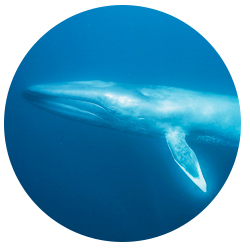 Blue Whale - The blue whale is truly an incredible sight. Whale Watching Long Beach visitors will have the opportunity to witness the largest animal that has ever existed on Earth. Large Blue Whales are the size of a Boeing Jet, weighing up to 150 tons. Larger whales can go up to 100 feet long. Fifty humans can stand on a Blue Whale's tongue and its heart is the size of a car. It's throat can take in up to 50 tons of water in one gulp and it's spout shoots water up over 30 feet when surfacing for air. Blue Whales can consume up to six tons of krill in a single day using their large throats to take in water and use a huge, comb-like plate system called baleen within their bodies to parse through water for the krill. These plates in the baleen system are made from the same material as human fingernails.
Blue Whale - The blue whale is truly an incredible sight. Whale Watching Long Beach visitors will have the opportunity to witness the largest animal that has ever existed on Earth. Large Blue Whales are the size of a Boeing Jet, weighing up to 150 tons. Larger whales can go up to 100 feet long. Fifty humans can stand on a Blue Whale's tongue and its heart is the size of a car. It's throat can take in up to 50 tons of water in one gulp and it's spout shoots water up over 30 feet when surfacing for air. Blue Whales can consume up to six tons of krill in a single day using their large throats to take in water and use a huge, comb-like plate system called baleen within their bodies to parse through water for the krill. These plates in the baleen system are made from the same material as human fingernails.
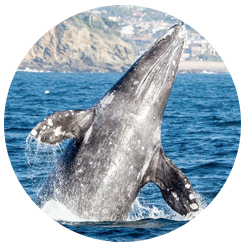 Grey Whale - Whale Watching Long Beach visitors will have a chance to bear witness to the California Grey Whale, also a type of baleen whale that uses the baleen system within their bodies to strain through krill. The California Grey Whale stands among the largest species of whales, but are still roughly half the size of their Blue Whale cousins. They generally weigh somewhere between 22 to 35 tons, and are 35 to 45 feet in length, with the females being larger than the males. These California Grey Whales travel over 8,000 miles a year from their feeding grounds in the North, where they feed on amphipods in cold arctic waters. During the fall and winter they travel all the way south to the Baja California to breed.
Grey Whale - Whale Watching Long Beach visitors will have a chance to bear witness to the California Grey Whale, also a type of baleen whale that uses the baleen system within their bodies to strain through krill. The California Grey Whale stands among the largest species of whales, but are still roughly half the size of their Blue Whale cousins. They generally weigh somewhere between 22 to 35 tons, and are 35 to 45 feet in length, with the females being larger than the males. These California Grey Whales travel over 8,000 miles a year from their feeding grounds in the North, where they feed on amphipods in cold arctic waters. During the fall and winter they travel all the way south to the Baja California to breed.
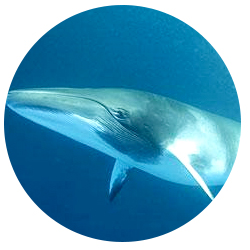 Finback Whale - Another amazing spectacle for Whale Watching Long Beach visitors is the Finback Whale. They are the second largest animal in the world after the Blue Whale. Growing up to nearly 90 feet long, Finback Whales are also the fastest type of whale, able to hit top speeds of 35 mph. Also a type of baleen whale, their bodies contain 800-900 plates to feed on fish and krill, eating up to 2-3 tons a day. Their spouts stand prominent, capable of rising over 20 feet in the air when surfacing. When these graceful Finback Whales surface, you'll be able to spot their heads, their dark features and also their long dorsal fin. Their tails are rarely seen as they surface horizontally and need only arch their backs to dive back into the sea.
Finback Whale - Another amazing spectacle for Whale Watching Long Beach visitors is the Finback Whale. They are the second largest animal in the world after the Blue Whale. Growing up to nearly 90 feet long, Finback Whales are also the fastest type of whale, able to hit top speeds of 35 mph. Also a type of baleen whale, their bodies contain 800-900 plates to feed on fish and krill, eating up to 2-3 tons a day. Their spouts stand prominent, capable of rising over 20 feet in the air when surfacing. When these graceful Finback Whales surface, you'll be able to spot their heads, their dark features and also their long dorsal fin. Their tails are rarely seen as they surface horizontally and need only arch their backs to dive back into the sea.
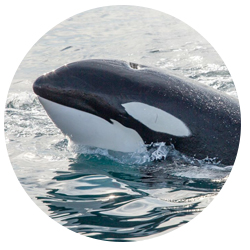 Killer Whale (Orca) - Whale Watching Dana Point visitors may spot the Orca Whale, commonly known as the Killer Whale because of their reputation as top notch predators of the sea. Often called wolves of the sea, Orca Whales hunt in packs and have tremendous size and strength. They are also one of the fastest types of whales, capable of traveling at over 35 mph. Each Killer Whale eats over 500 pounds of food a day and have been known to even swim into freshwaters. However, their migration patterns are not yet fully understood by scientists. Their pods have been sighted from Alaska all the way down to California.
Killer Whale (Orca) - Whale Watching Dana Point visitors may spot the Orca Whale, commonly known as the Killer Whale because of their reputation as top notch predators of the sea. Often called wolves of the sea, Orca Whales hunt in packs and have tremendous size and strength. They are also one of the fastest types of whales, capable of traveling at over 35 mph. Each Killer Whale eats over 500 pounds of food a day and have been known to even swim into freshwaters. However, their migration patterns are not yet fully understood by scientists. Their pods have been sighted from Alaska all the way down to California.
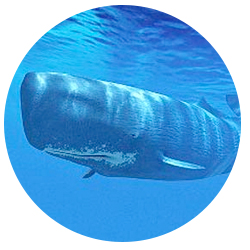 Sperm Whale - Whale Watching Dana Point visitors may also spot the Sperm Whale. The Sperm Whale has the largest brain of any animal in existence, with their brains weighing up to twenty pounds! Sperm Whales are toothed whales and live together in pods. Sperm Whales have unique S-shaped blowholes on the front left side of their large heads. Adult can weigh up to 50 tons and grow to be 50-60 feet in length. Naturally, with their large brains, Sperm Whales also have the largest heads of any animal, comprising a third of the Sperm Whale's body mass and featuring a distinct, boxy shape. Their heads often feature prominent scars from the giant squids that they call prey.
Sperm Whale - Whale Watching Dana Point visitors may also spot the Sperm Whale. The Sperm Whale has the largest brain of any animal in existence, with their brains weighing up to twenty pounds! Sperm Whales are toothed whales and live together in pods. Sperm Whales have unique S-shaped blowholes on the front left side of their large heads. Adult can weigh up to 50 tons and grow to be 50-60 feet in length. Naturally, with their large brains, Sperm Whales also have the largest heads of any animal, comprising a third of the Sperm Whale's body mass and featuring a distinct, boxy shape. Their heads often feature prominent scars from the giant squids that they call prey.
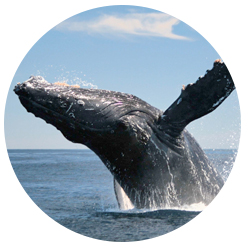 Humpback Whale - Whale Watching Dana Point visitors may also see the Humpback Whale, one of the larger species of Whales in existence. The Humpback Whale weighs on average about 79,000 pounds and vary in length from 40 to 50 feet. Humpback Whales feed in polar waters during the summertime and migrate to subtropical and tropical waters during winter to breed. Humpbacks whales do not eat in the winter, and rely upon the fat reserves that they've built up during the summer feeding months. Humpback Whales also hunt in groups of up to twelve, using unique methods to ensnare their prey. The group of Humpback Whales will blow bubbles while swimming in circles around a school of fish, creating a ring around the fish. The fish are confined to a smaller and smaller area as the whales continue the process, until the whales swim through the bubbles and swallow thousands of fish in a single gulp. It is truly a group effort as some whales are tasked with blowing bubbles, others herd fish with noises, others, dive deep to drive fish to the surface. zen Humpbacks.
Humpback Whale - Whale Watching Dana Point visitors may also see the Humpback Whale, one of the larger species of Whales in existence. The Humpback Whale weighs on average about 79,000 pounds and vary in length from 40 to 50 feet. Humpback Whales feed in polar waters during the summertime and migrate to subtropical and tropical waters during winter to breed. Humpbacks whales do not eat in the winter, and rely upon the fat reserves that they've built up during the summer feeding months. Humpback Whales also hunt in groups of up to twelve, using unique methods to ensnare their prey. The group of Humpback Whales will blow bubbles while swimming in circles around a school of fish, creating a ring around the fish. The fish are confined to a smaller and smaller area as the whales continue the process, until the whales swim through the bubbles and swallow thousands of fish in a single gulp. It is truly a group effort as some whales are tasked with blowing bubbles, others herd fish with noises, others, dive deep to drive fish to the surface. zen Humpbacks.
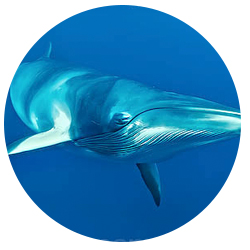 Minke Whale - Whale Watching Dana Point visitors will likely encounter Minke whales, the most common baleen whale in existence, numbering nearly 800,000 across the globe. As with all Baleen Whales, Female Minke Whales are larger. The species grows up to 30 feet long and weigh up to 7.5 tons.Minke Whales normally swim at a rate of 3-16 miles per hour, but can sprint up to 18-21 miles per hour when feeling danger.
Minke Whale - Whale Watching Dana Point visitors will likely encounter Minke whales, the most common baleen whale in existence, numbering nearly 800,000 across the globe. As with all Baleen Whales, Female Minke Whales are larger. The species grows up to 30 feet long and weigh up to 7.5 tons.Minke Whales normally swim at a rate of 3-16 miles per hour, but can sprint up to 18-21 miles per hour when feeling danger.
Dolphin species commonly viewed while Whale Watching
 Common Dolphin - Whale Watching Dana Point visitors will also likely see the Common Dolphin. The Common Dolphin generally weighs about 160 pounds and is 5 to 8 feet long. They are the fastest species of small dolphin, and hit top speeds of over 27 miles per hour. Common dolphins live and travel in enormous pods sometimes numbering thousands. They are highly social and are extremely energetic, making lots of whistling, pulse, and click noises. They often leap out of the water individually or in groups, and often like to ride the bow waves of our boats. Common Dolphins are known to be one of the most intelligent animals on Earth.
Common Dolphin - Whale Watching Dana Point visitors will also likely see the Common Dolphin. The Common Dolphin generally weighs about 160 pounds and is 5 to 8 feet long. They are the fastest species of small dolphin, and hit top speeds of over 27 miles per hour. Common dolphins live and travel in enormous pods sometimes numbering thousands. They are highly social and are extremely energetic, making lots of whistling, pulse, and click noises. They often leap out of the water individually or in groups, and often like to ride the bow waves of our boats. Common Dolphins are known to be one of the most intelligent animals on Earth.
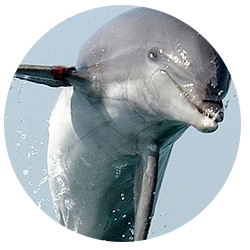 Bottlenose Dolphin - Whale Watching Dana Point customers may also encounter Bottlenose Dolphins. Bottlenose Dolphins generally weigh 440 to 600 pounds and some are known to be as long as 14 feet, but most fall just under 10 feet. Bottlenose Dolphins have tremendous lifespans, often living thirty to fifty years. They eat anywhere from thirteen to thirty-three pounds of fish, squid, octopus, and other sea creatures a day. Bottlenose Dolphins utilize echolocation, the bouncing of sounds off objects to determine the position of objects, in order to hunt their prey.
Bottlenose Dolphin - Whale Watching Dana Point customers may also encounter Bottlenose Dolphins. Bottlenose Dolphins generally weigh 440 to 600 pounds and some are known to be as long as 14 feet, but most fall just under 10 feet. Bottlenose Dolphins have tremendous lifespans, often living thirty to fifty years. They eat anywhere from thirteen to thirty-three pounds of fish, squid, octopus, and other sea creatures a day. Bottlenose Dolphins utilize echolocation, the bouncing of sounds off objects to determine the position of objects, in order to hunt their prey.
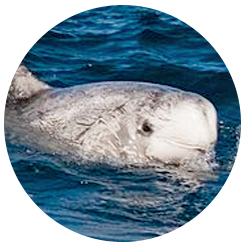 Risso Dolphin - Whale Watching Dana Point visitors may also see the Risso's Dolphins, also known as "gray dolphins." Risso's Dolphins have thick bodies and narrow tails. They weigh anywhere from 660 to 1,100 pounds and are 8.5 to 13 feet in length. They are also found in pods, with pod sizes varying from 5 to 50, but usually falling within the 10 to 30 range. Rissos are able to dive for 30 minutes down to over 1,000 feet below, but generally make short dives lasting between one to two minutes. Rissos tend to hunt at night when their prey of anchovies, krill, and squid are closer to the surface.
Risso Dolphin - Whale Watching Dana Point visitors may also see the Risso's Dolphins, also known as "gray dolphins." Risso's Dolphins have thick bodies and narrow tails. They weigh anywhere from 660 to 1,100 pounds and are 8.5 to 13 feet in length. They are also found in pods, with pod sizes varying from 5 to 50, but usually falling within the 10 to 30 range. Rissos are able to dive for 30 minutes down to over 1,000 feet below, but generally make short dives lasting between one to two minutes. Rissos tend to hunt at night when their prey of anchovies, krill, and squid are closer to the surface.
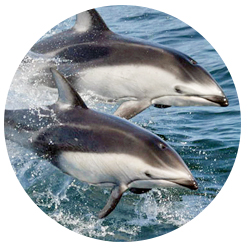 Pacific White Sided Dolphin - Whale Watching Dana Point patrons may also have an opportunity to view the Pacific White-sided Dolphin. Male Pacific White-side Dolphins weigh up to 440 lbs and females weigh up to 330 lbs. The males get up to 8 feet in length while the females are smaller, at about 6.5 feet in length. Among their distinct features are dark grey rings around their eyes and unique coloration on various parts of their bodies. They generally have three different colors on their bodies. Their chins, throats, and bellies are a creamy white shade. Their beaks, flippers, backs, and dorsal fins are dark grey. The Pacific White Sided Dolphin will also have light grey patches on its sides, and a light gray stripe running from its eyes to its dorsal fin, where the stripe becomes thicker all the way to its tail.
Pacific White Sided Dolphin - Whale Watching Dana Point patrons may also have an opportunity to view the Pacific White-sided Dolphin. Male Pacific White-side Dolphins weigh up to 440 lbs and females weigh up to 330 lbs. The males get up to 8 feet in length while the females are smaller, at about 6.5 feet in length. Among their distinct features are dark grey rings around their eyes and unique coloration on various parts of their bodies. They generally have three different colors on their bodies. Their chins, throats, and bellies are a creamy white shade. Their beaks, flippers, backs, and dorsal fins are dark grey. The Pacific White Sided Dolphin will also have light grey patches on its sides, and a light gray stripe running from its eyes to its dorsal fin, where the stripe becomes thicker all the way to its tail.
Our Whale Watching Dana Point visitors may also see: Giant Sun Fish, Marlin, Swordfish, Jellyfish, Pelican, Seagulls, Mako Sharks, as well as other sharks various other creatures.

Whale watching coupons for Dana Point visitors. Save 60% with this $18 whale watching cruise special. Newport Landing's Dana Point whale watching coupon is a great offer that can be used on any of our whale watching & dolphin cruises. The whale watching cruise coupon is valid for up to 10 persons per coupon and is valid for any of our 2.5 hour whale watching cruises offered year round multiple times daily departing from Newport Beach. View the annual gray whale migration during the winter and spring months and the giant blue whales during the summer and fall months.
Reserve your whale-watching trip!
Newport Whales runs whale watching excursions multiple times a day seven days a week all year long. Along with viewing Whales you can expect to see dolphins, sea lions, marine birds, and other neat marine creatures. Please try to arrive at least 30 minutes before your cruise departure time. Need help with directions or parking or for making reservations on cruises less than 24 hours away, please give us a call (949) 675-0551.
BOOK ONLINE BELOW FOR $19 SPECIAL
OR CALL (949) 675-0551 AND MENTION PROMO: WHALEWATCH18DEAL
SHARE
FOR RESERVATIONS, CALL (949) 675-0551